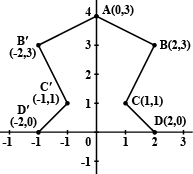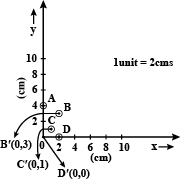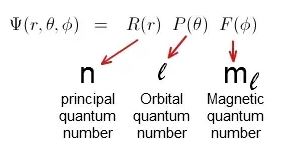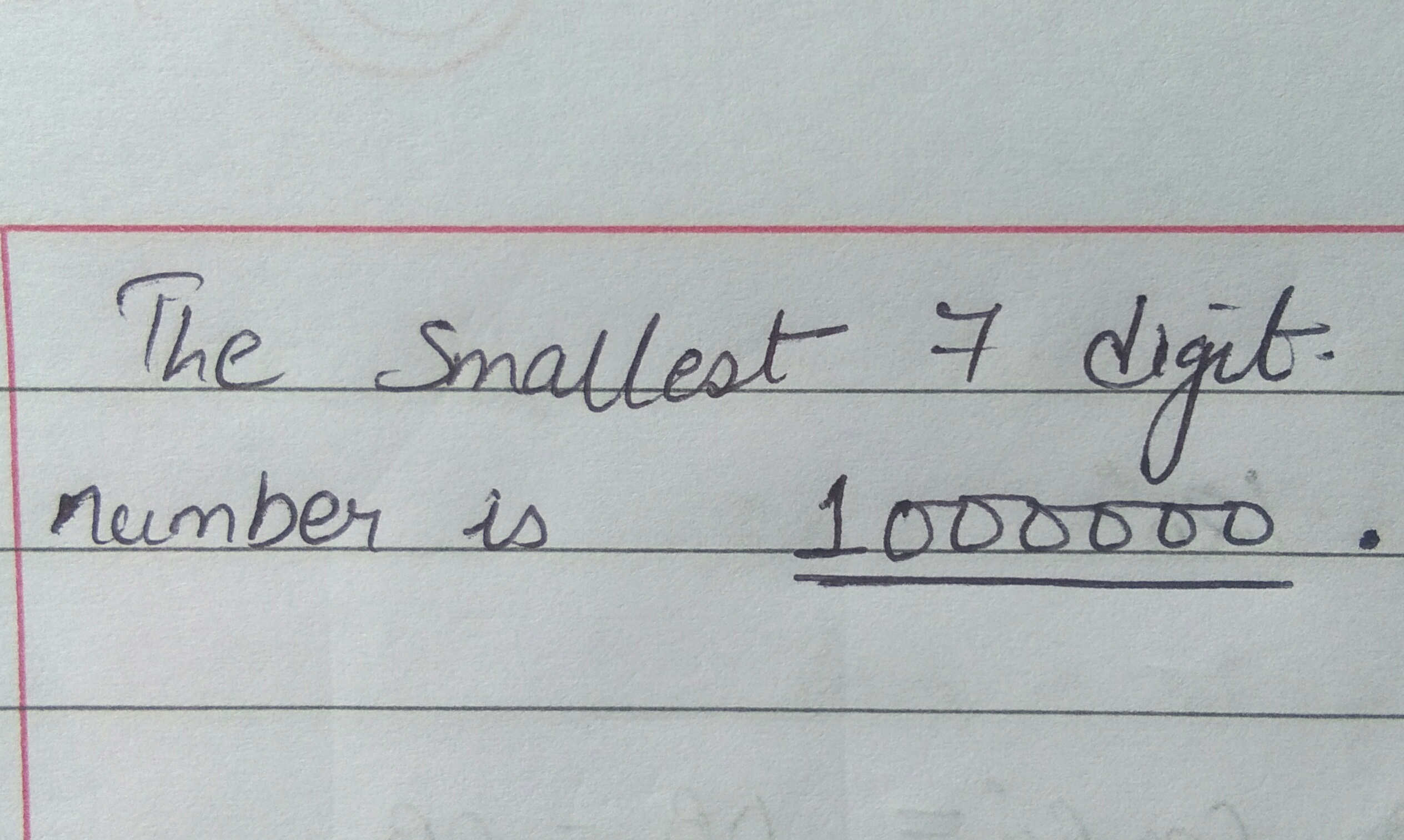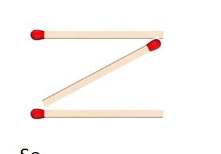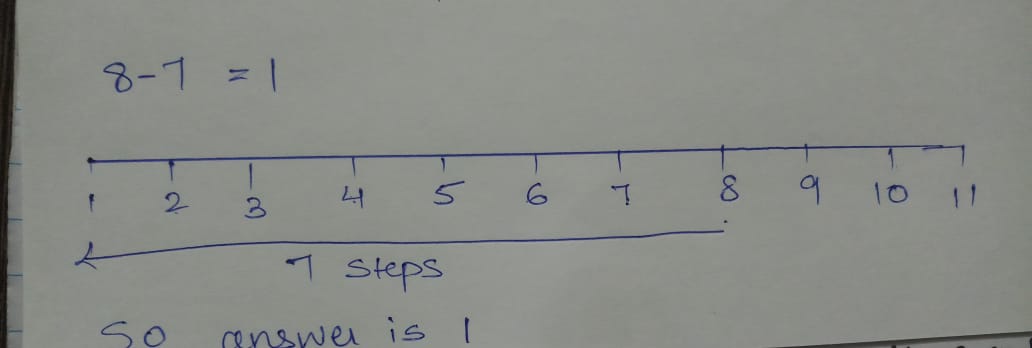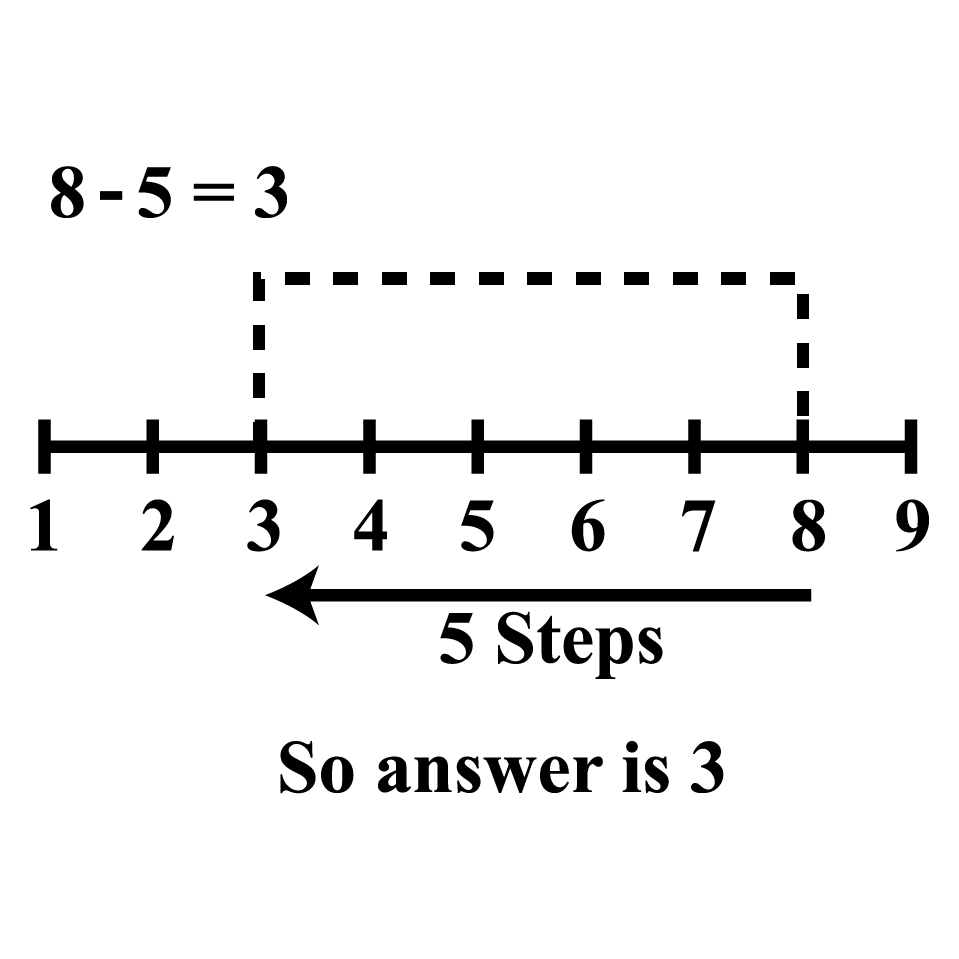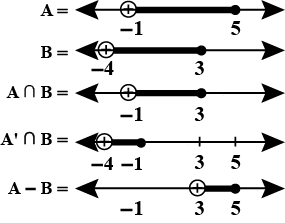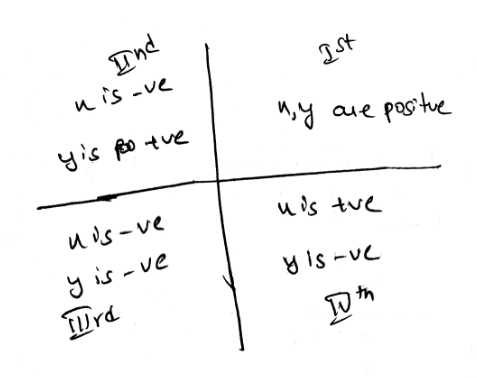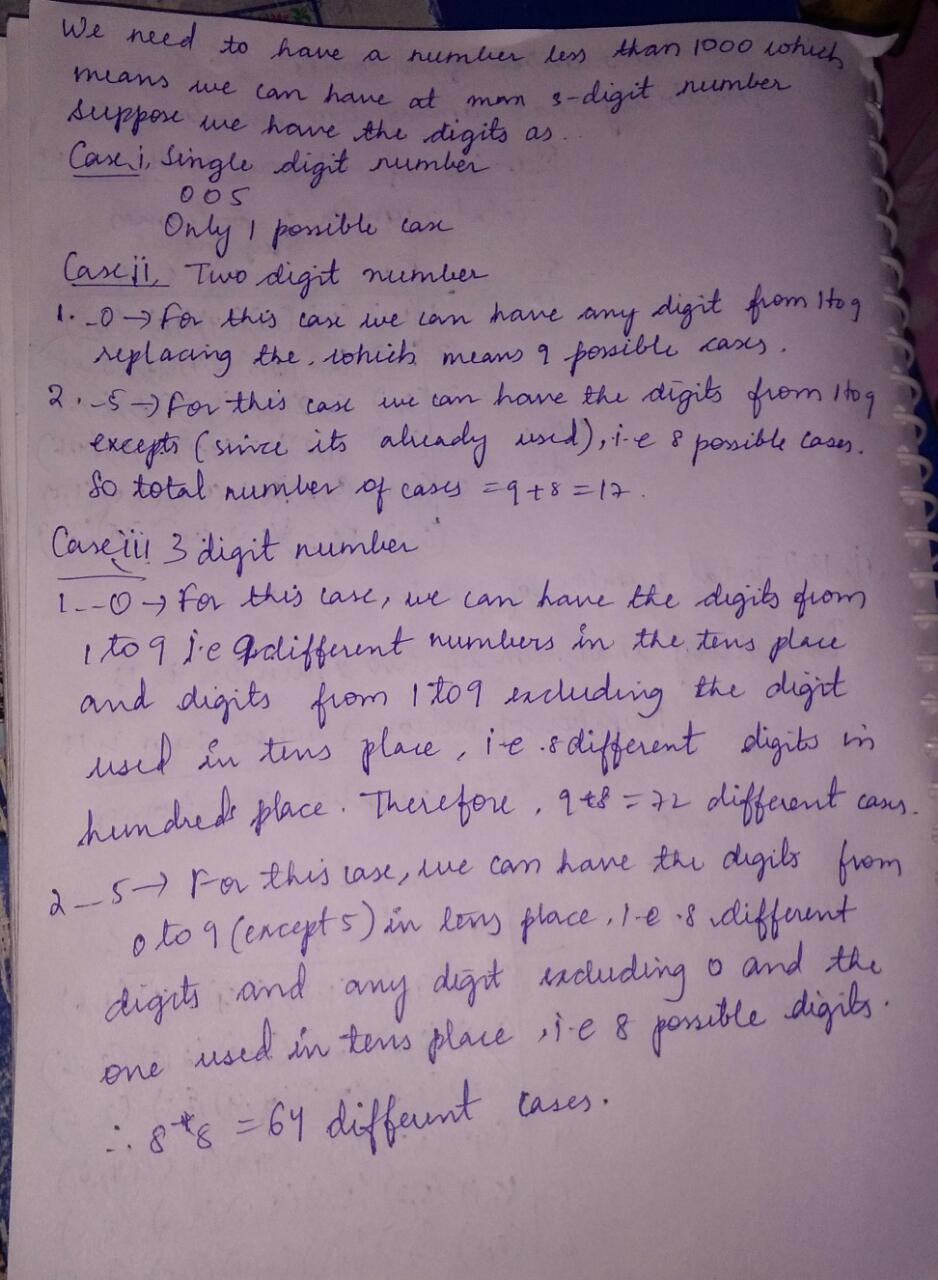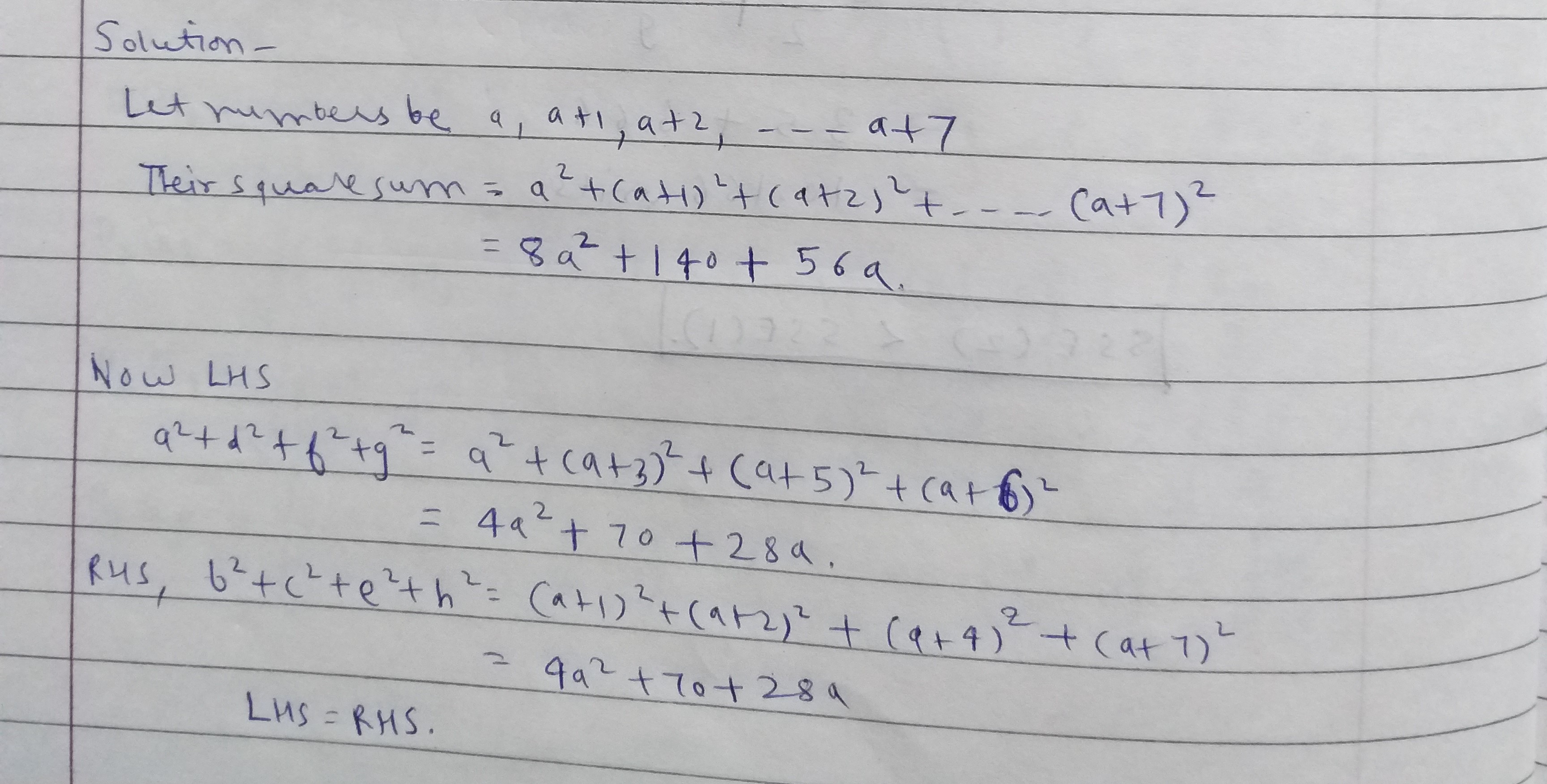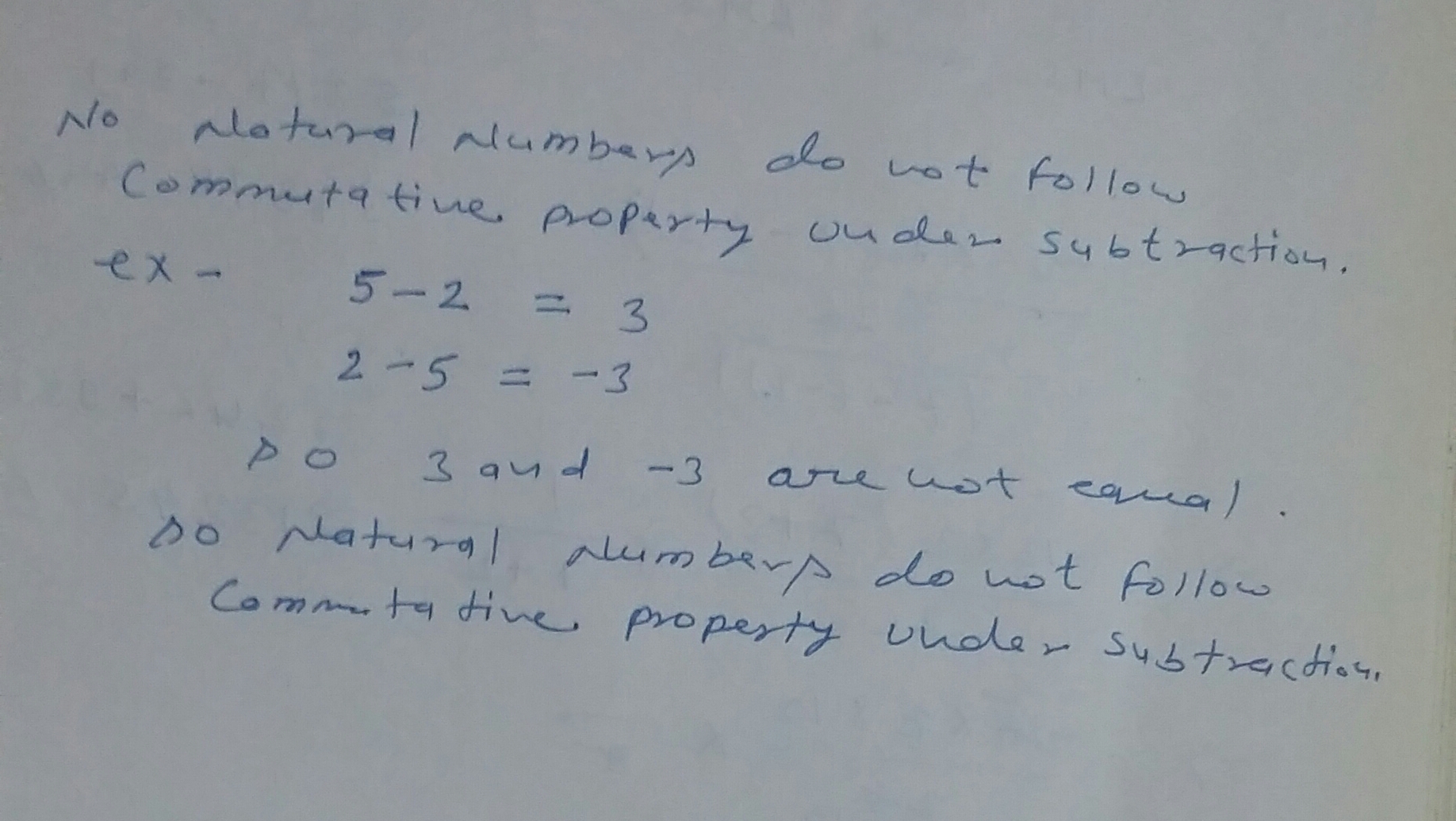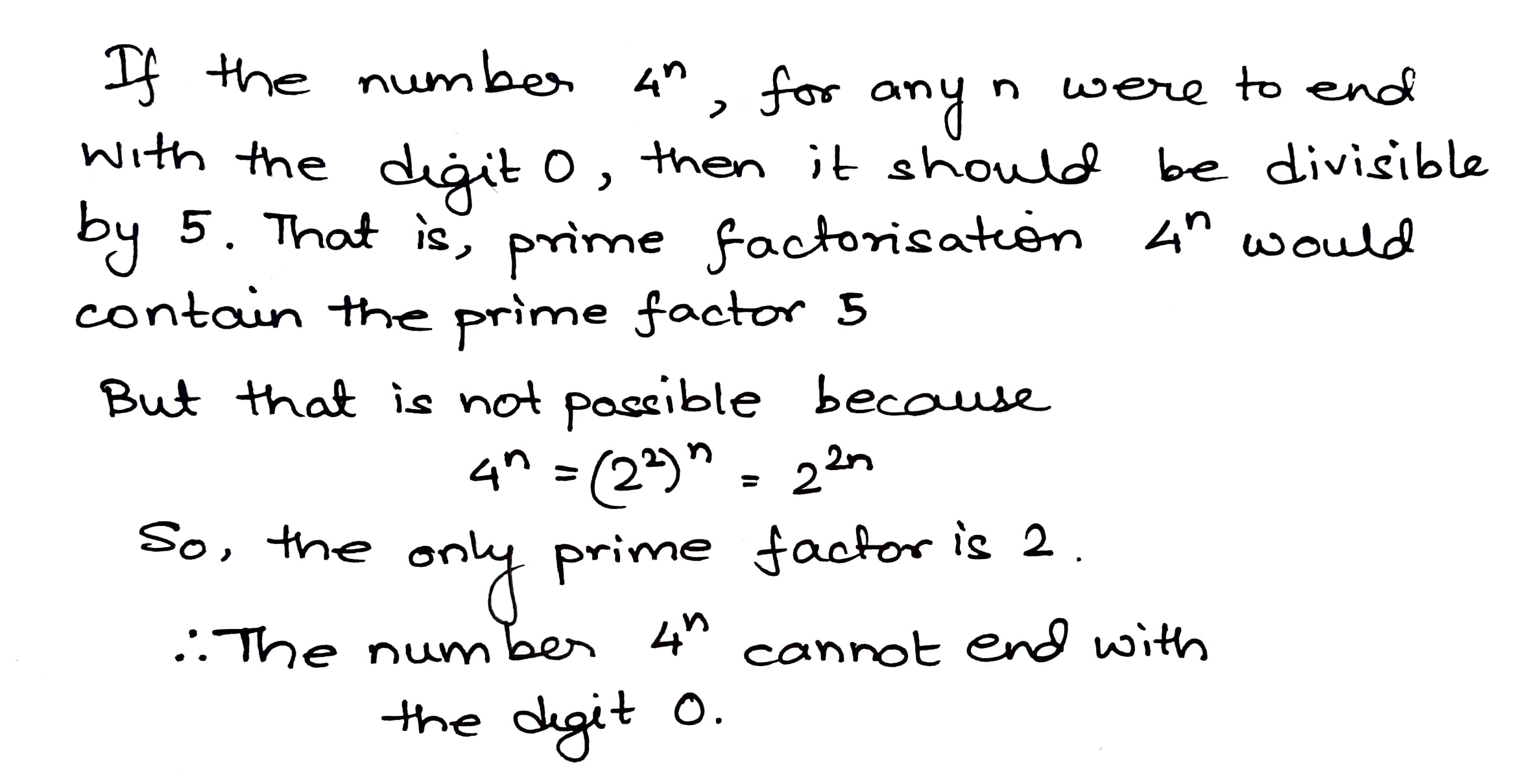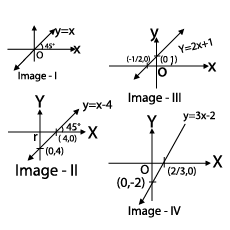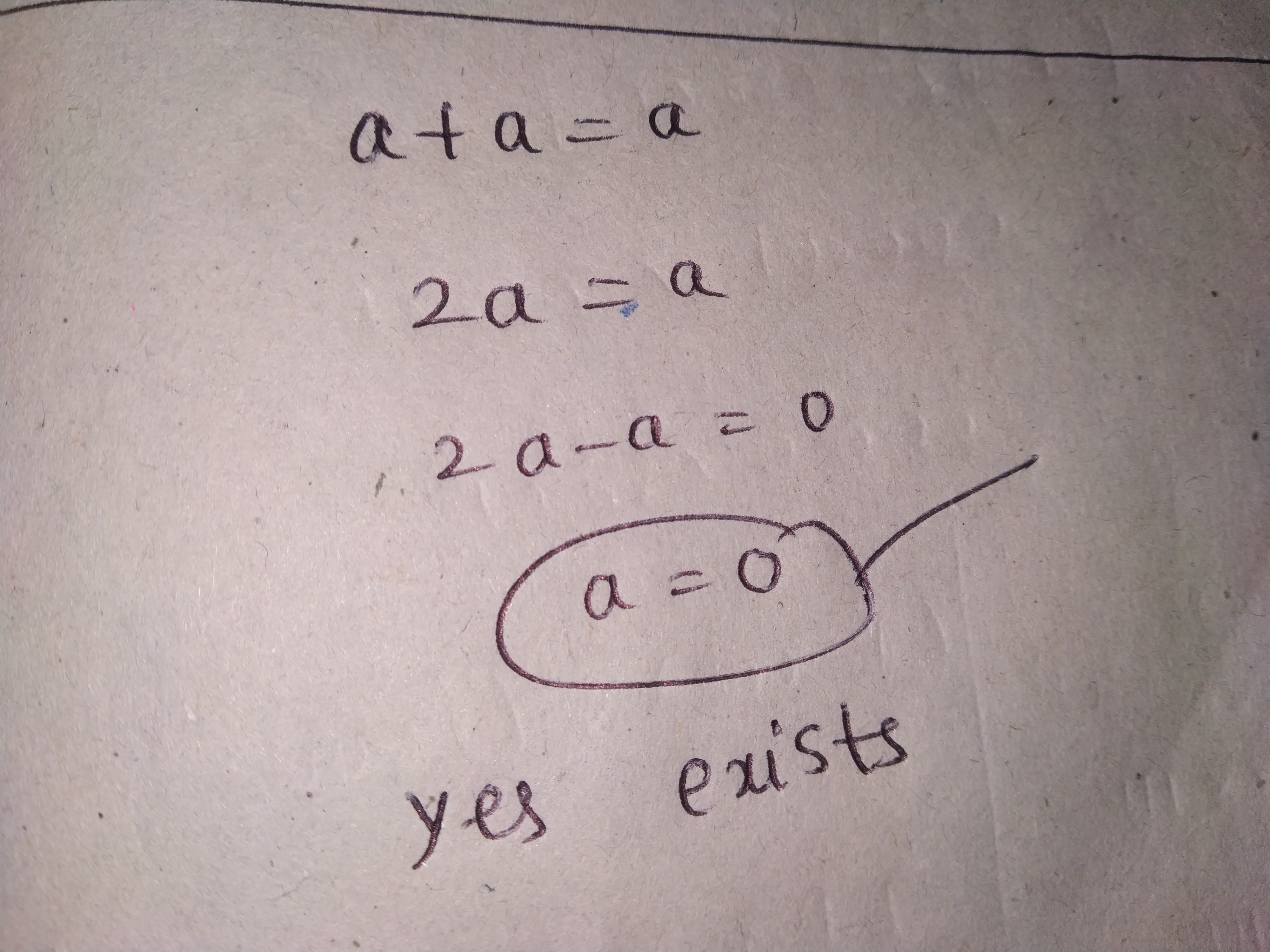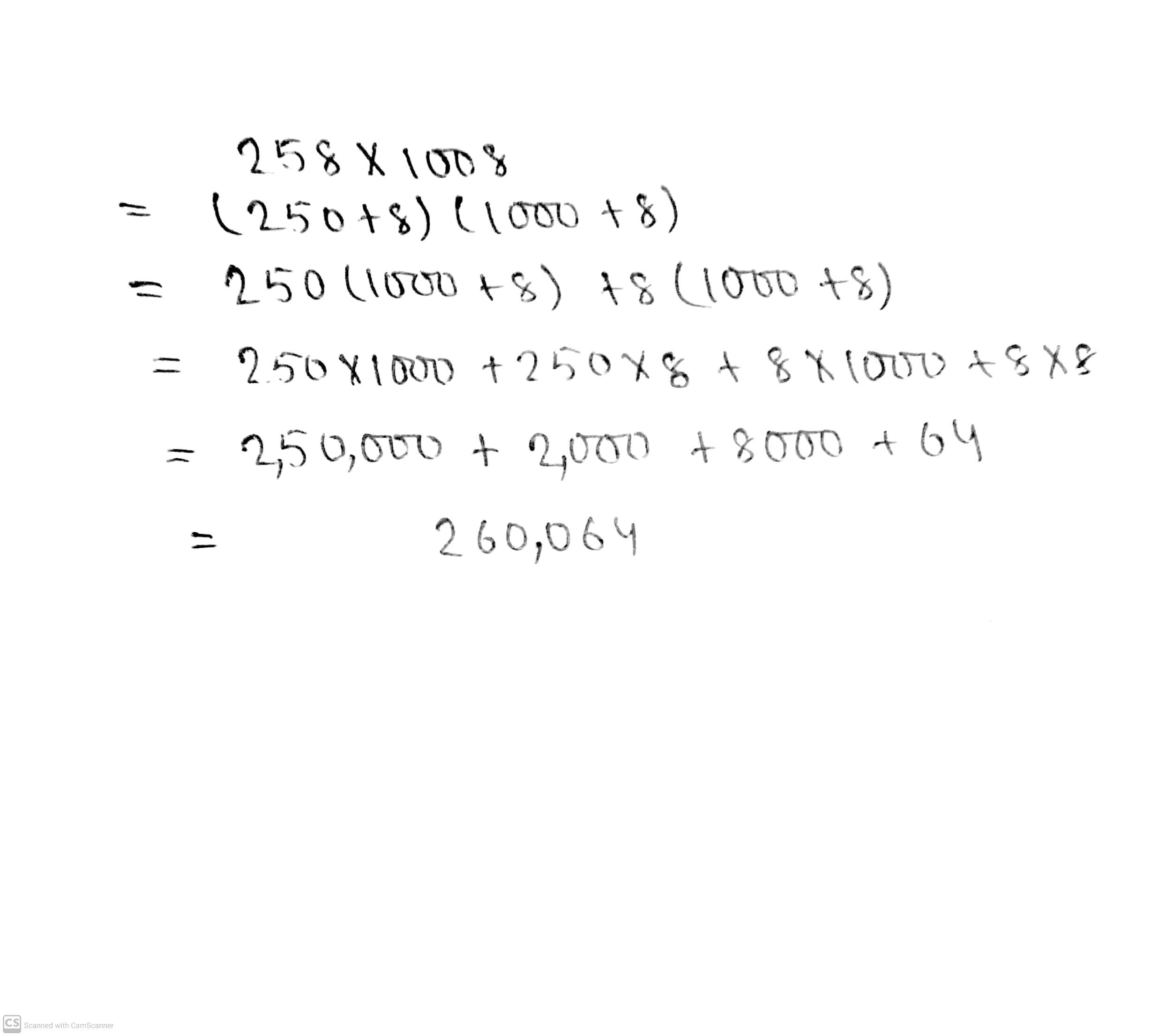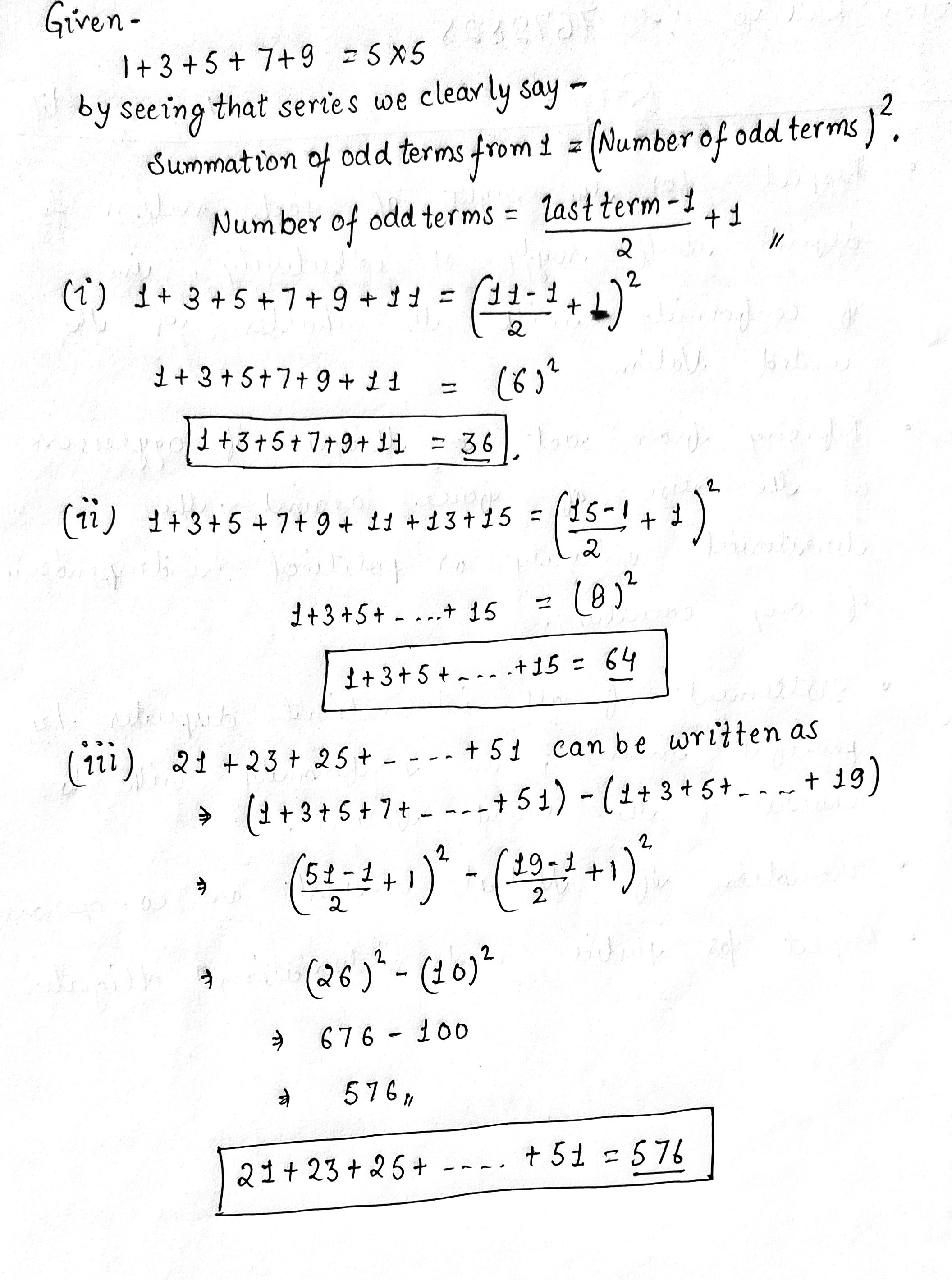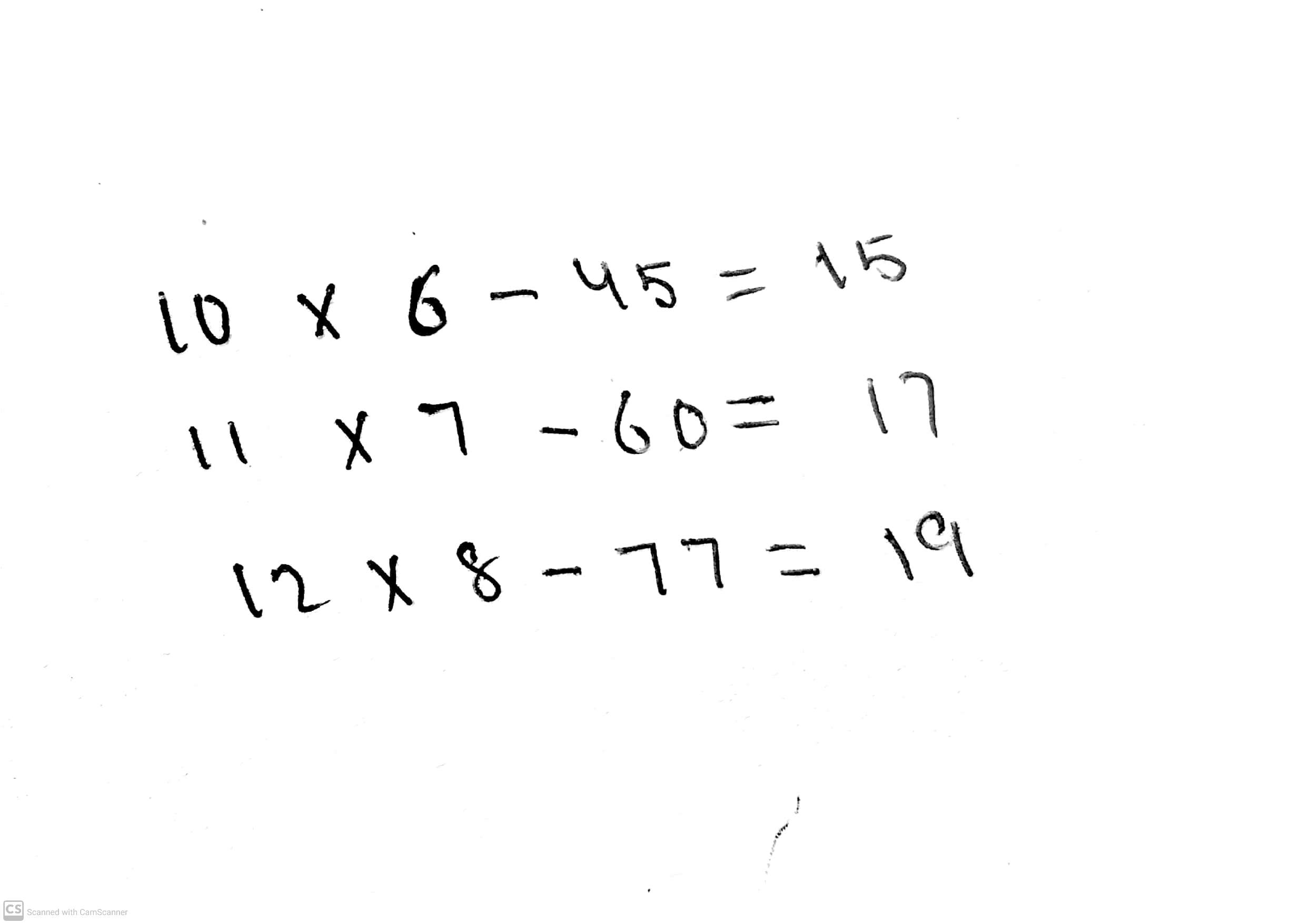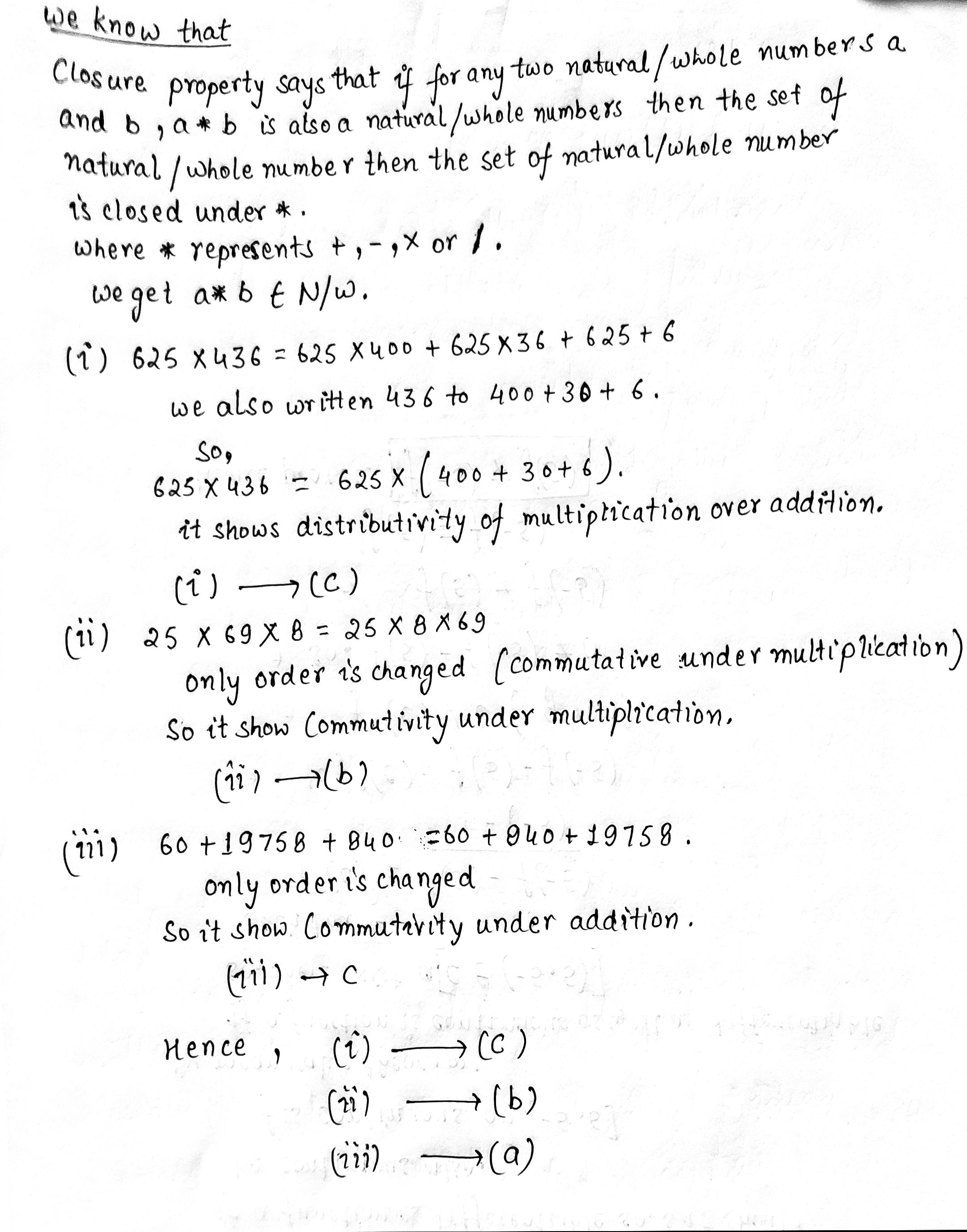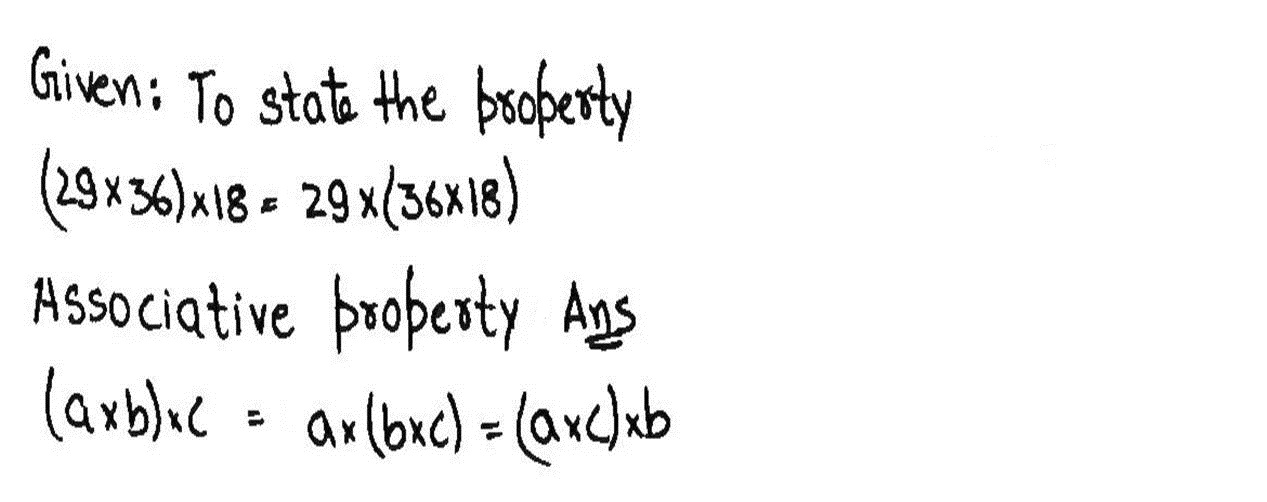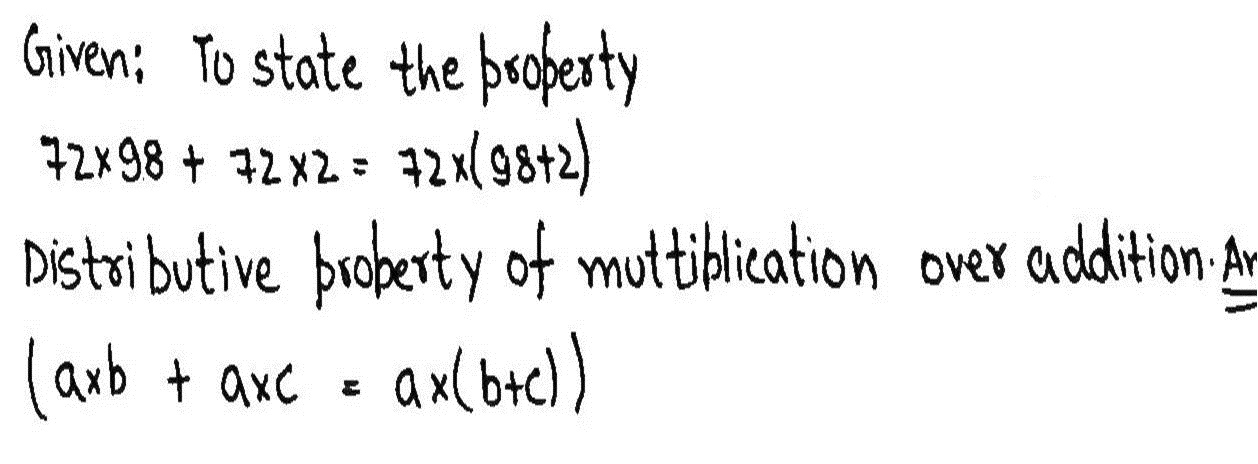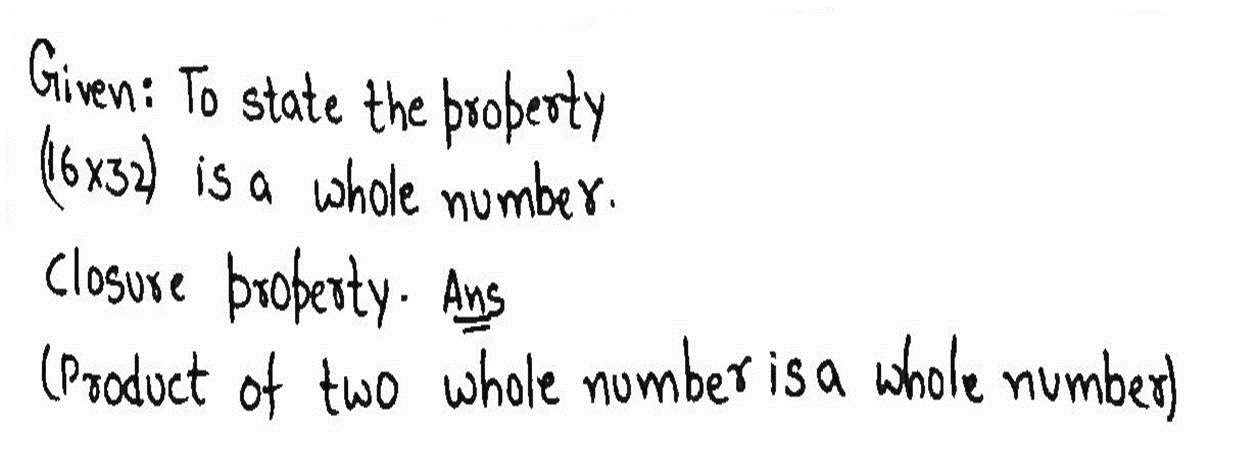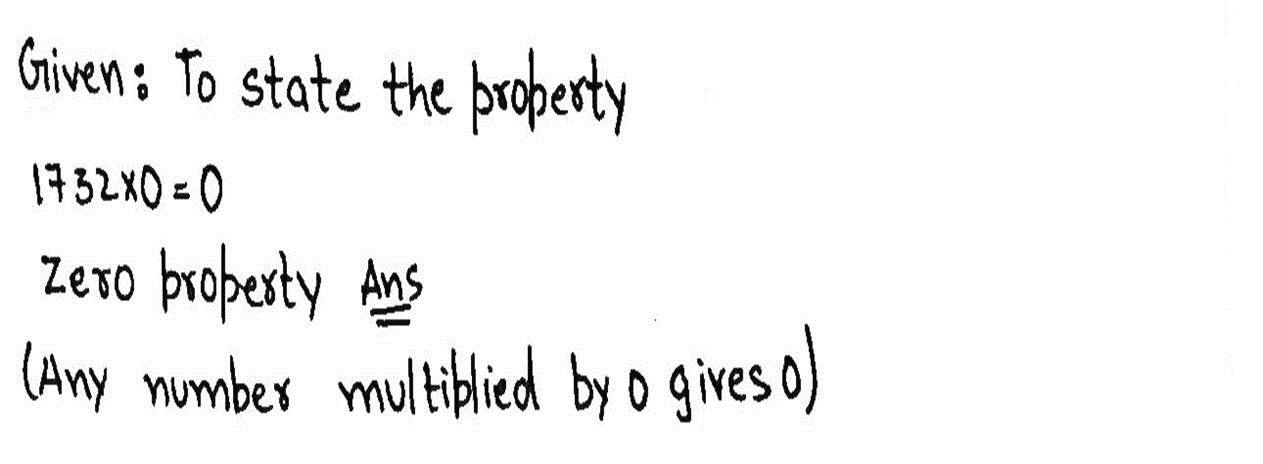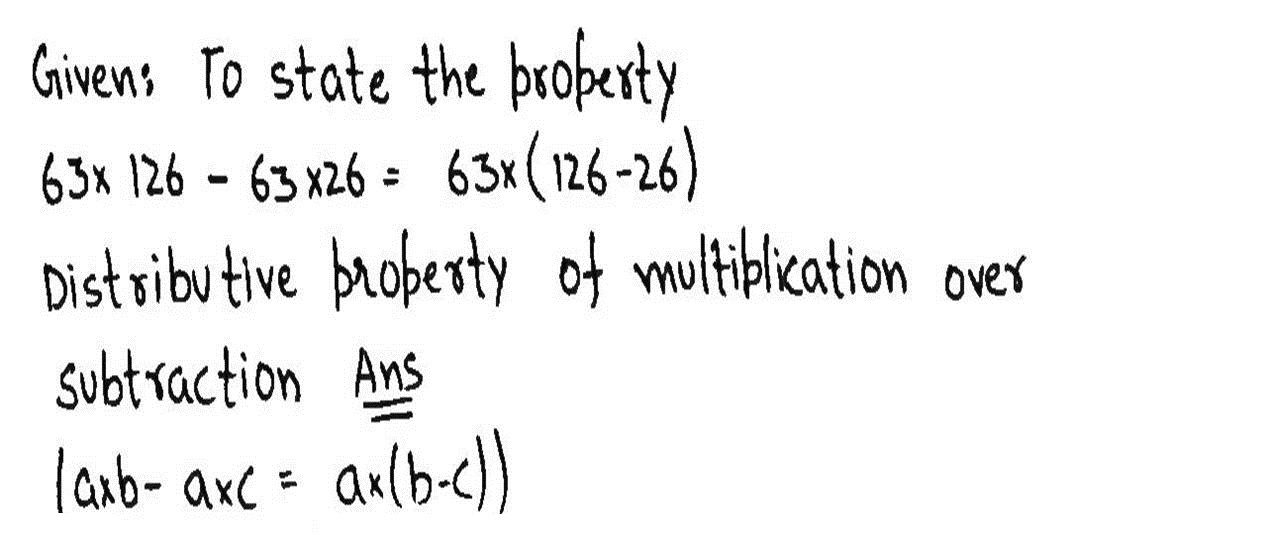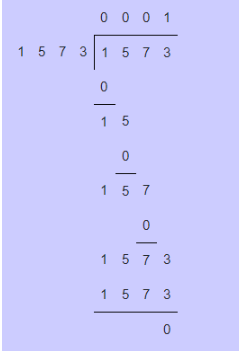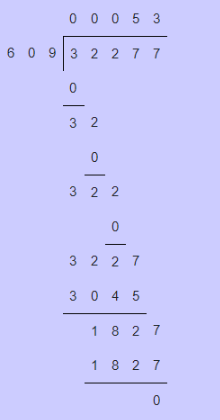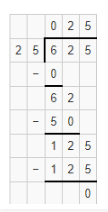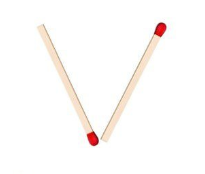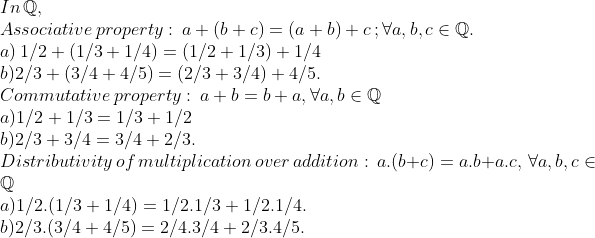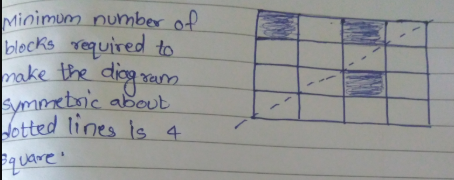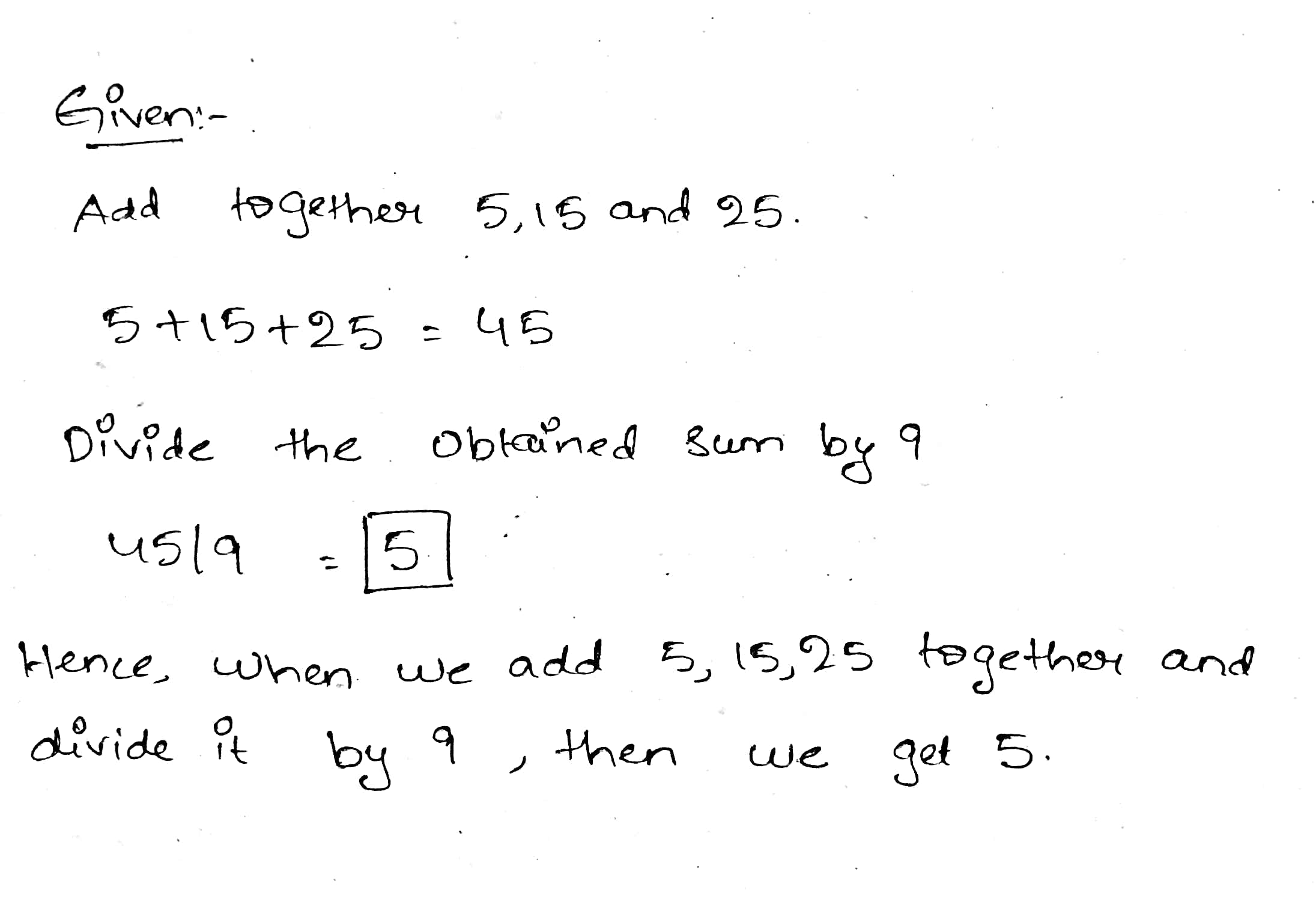Whole Numbers - Class 6 Maths - Extra Questions
Every natural number is a whole number, if true then enter $$1$$ and if false then enter $$0$$
Predecessor of $$801010$$ is _____
Find the additive inverses of the following integers:
$$6, 9, 123, -76, -85, 1000$$
Find the integer $$m$$ in the following:
$$m + 25 = 15$$
How many rational numbers are there strictly between $$0$$ and $$1$$ such that the denominator of the rational number is $$80$$?
Write the additive inverse of : $$\dfrac{2}{7}$$
Restate the following statements with appropriate conditions, so that they become true statements.
For any $$x, x^3\geq 0$$.
Write down $$15$$ rational numbers which are equivalent to $$\dfrac{11}{5}$$ and the numerator not exceeding $$180$$
Earlier you have studied decimals $$0.9, 0.8$$. Can you write these as rational numbers?
Name the property involved in the given example: $$\dfrac{2}{5} + \dfrac{1}{3} = \dfrac{1}{3} + \dfrac{2}{5}$$
How many trees are on the right side of the house?

Find the sum by suitable rearrangement:
$$238 + 695 + 162 $$
Join the points A, B, C, D, D', C', B' and A in order, so as to form a closed figure. Write down the equation of the line of symmetry of the figure formed.
Reflect points B, C, D on the y-axis and write down their coordinates. Name the images as B', C', D' respectively.
Find the sum $$ 154 + 197 + 46 + 203$$
Verify whether commutative property is satisfied for addition, subtraction, multiplication and division of the following pairs of rational numbers.
(i) $$4$$ and $$\dfrac {2}{5}$$
(ii) $$\dfrac {-3}{7}$$ and $$\dfrac {-2}{7}$$
Find the square root:
(1) $$\displaystyle \frac{36}{49}$$
(2) $$\displaystyle \frac{484}{625}$$
(3) $$\displaystyle 5\frac{19}{25}$$
(4) 72.25
(5) 39.69
Find the integer m in the following:
$$m + 28 = -49$$
Write the smallest natural number. Can you write the largest natural number?
Is it right to say that the median of first 'n' natural numbers is $$\cfrac { n+1 }{ 2 } $$? Justify?
Write all the primes less than $$25$$, to which number set the square roots of these prime numbers belongs to?
Write the following numbers in word:
$$(i) 5,27,864 $$ $$ (ii) 95,432$$
How are the quantum numbers $$n$$, $$1$$ and $$m_{1}$$ arrived at? Explain the significance of these quantum numbers.?
Between which two numbers in the tenths place on the number line does each of the given number lies$$0.17$$, $$0.54$$, $$0.61$$, $$0.78$$
Change these numbers into special numbers
$$(i)\ 28\ \\ (ii)\ 132$$
Find the following product.
$$2dc^{2}\times -6dc$$
Write down three consecutive predecessors of $$7510001$$.
Write the following numbers in Hindu-Arabic system.
(i) $$1256345$$ (ii) $$12027896$$
List first $$n$$ natural numbers
Use distributive law to find the value of
$$1063 \times 128 - 1063 \times 28$$.
Add $$8+(-5)$$ on number line.
Write first ten Natural Numbers.
Write first 10 Whole Numbers.
Find how many three digits natural numbers are divisible by $$5$$.
Find the sum of the smallest five-digit and six-digit numbers?
If $$x - \frac{1}{x} = 3$$ then find the value of $$x ^ { 3 } - \dfrac { 1 } { x ^ { 3 } }$$
Find the ratio of:
$$15\ kg$$ to $$210\ g$$
Separate the periods of the numeral $$'93574862'$$ by commas and write it in words.
From the following pairs of numbers, find the reduced form of ratio of first number second number.
$$52,78$$
Find the reduced form of the ratio of the first quantity to second quantity.
$$5\ litre,\ 2500\ ml$$
Find the coordinates of the points $$A,B,C,D$$ from the following graph.
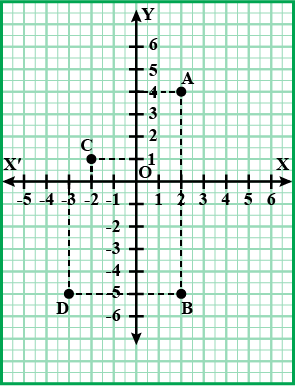
Express the following presentages as ratios in the reduced form.
$$44:100$$
Answer the following question:
The counting numbers are also called ________
2025 plants are to be planted in a garden in such a way that each row contains as many plants as the number of rows. Find the number of rows and the number of plants in each row.
Solve
$$\left(\dfrac {5}{3}\right)^{3/2}$$
Fill in the blanks:
The smallest $$7-$$digits number in the system_____
$$B = \{ x | 5 x - 2 = 0 , x \in N \}$$
$$(i)$$Which is the smallest whole number?$$(ii)$$Which is the smallest natural number ?
Rajni is 6th from either end of a row of girls. How many girls are there in that row ?
Solve:
$$\dfrac {1}{7}+\dfrac {3}{14}$$
Show that the number $$4^{n}$$, when n is a natural number cannot end with the digit zero
Is there any natural number which has no successor?
How many whole numbers are there between $$32$$ and $$53$$?
A student multiplied $$7236$$ by $$65$$ instead of multiplying by $$56$$. By how much was his answer greater than the correct answer?
Is there any natural number that has no predecessor?
Are all natural numbers also whole numbers?
Which is the greatest whole number?
Are all whole numbers also natural numbers?
Which is the smallest whole number?
Find the product using suitable properties.
$$738\times 103$$.
Find the value of the following.
$$81265\times 169-81265\times 69$$.
Find the value of the following.
$$54279\times 92+8\times 54279$$.
Find $$15\times 68$$ using distributive property.
Find the value of the following.
$$3845\times 5\times 782+769\times 25\times 218$$.
Find $$17\times 23$$ using distributive property.
Find the product using suitable properties.
$$854\times 102$$.
Find the value of the following.
$$297\times 17+297\times 3$$.
Find $$69\times 78+22\times 69$$ using distributive property.
Find the product using suitable properties.
$$258\times 1008$$.
Find using distributive properly.
$$4275\times 125$$.
How many whole numbers are there between $$1032$$ and $$1209$$?
Find using distributive properly.
$$5437\times 1001$$.
Find using distributive properly.
$$728\times 101$$.
Add the following numbers and check by reversing the order of the addends:
$$2359 + 548$$
Write three consecutive whole numbers occuring just before $$320001.$$
Determine the sums given below using suitable rearrangement.
$$1 + 2 + 3 + 4 + 96 + 97 + 98 + 99$$
Find the product using suitable properties.
$$1005\times 168$$.
Find using distributive property:
$$824\times 25$$
Add the following numbers and check by reversing the order of the addends:
$$19753 + 2867$$
Natural number are closed under ____ and under ____.
$$32 \times (27 \times 19)=(32 \times $$ ______$$) \times 19$$
Smallest natural number is ..
Fill in the blanks:
The additive identity in whole numbers is............
Using suitable properties, evaluated the following:
$$724\times (-56)+(-724)\times 44 $$
Can a rectangular number be a square number ?
Fill in the blanks:
$$(-10)\times ((-15)\times 33)=$$______ $$\times (-15)+(-10)\times 33$$
Find the rule which gives the number of matchsticks required to make the following matchsticks patterns.
Use a variable to write the rule.
A pattern of letter $$Z$$ as
$$54 + 234 = 234 + $$
Largest natural number is
Smallest whole number is
Largest whole number is ..
All natural numbers are
$$332 + 497 = + 332$$
Represent the following whole numbers on a number line:
$$0, 3, 5, 8, 10$$
Is $$a + b + c = a + (b + c) = (b + a) + c$$ ?
$$a + (b + c) = (a + ) + c$$
By re-arranging the given numbers, evaluate: $$162 + 253 +338 + 47$$
Which property of addition is satisfied by: $$8 + 7 = 15$$
By re-arranging the given numbers, evaluate: $$237 + 308 + 163$$
Which property of addition is satisfied by: $$3+ (5 + 4) = (3 + 5)+ 4$$
Evaluate: $$355 \times 18$$.
Evaluate: $$6214 \times 12$$.
Evaluate: $$15 \times 49372$$.
Let $$N$$ denote the set of all natural numbers and $$R$$ be the relation on $$N\times N$$ defined by $$(a, b) R (c, d)\Longleftrightarrow ad (b+c)=bc(a+d)$$. Check weather $$R$$ is an equivalence relation.
What are the properties of $$R$$ used in the following? $$0+0=0$$
Identify the property in the following statements:
$$8\cdot (6 + 5) = (8\cdot 6) + (8\cdot 5)$$
Is $$\dfrac {3}{-2}$$ a rational number? If so, how do you write it in a form conforming to the definition of a rational number (that is, the denominator as a positive integer)?
Give an example to show that subtraction on the set of real numbers is not commutative.
Write the additive inverse of : $$\dfrac{-11}{5}$$
Find an irrational number between $$3$$ and $$4$$
Write down ten rational numbers which are equivalent to $$\dfrac{5}{7}$$ and the denominator not exceeding $$80$$
How many rational numbers are there strictly between $$0$$ and $$1$$ with the property that the sum of the numerator and denominator is $$70$$?
Name the property indicated in the following:
$$5 + 0 = 0 + 5 = 5$$
Name the property involved in the given question: $$\dfrac{8}{5} + 0 = \dfrac{8}{5} = 0 + \dfrac{8}{5}$$
If $$a = \dfrac {\sqrt {3} - 1}{ \sqrt {3} + 1}, b = \dfrac {\sqrt {3} + 1}{ \sqrt {3} - 1}$$, then find the value of $$a + b + ab$$.
Show that the sum of the first $$n$$ natural numbers is a perfect square, if $$n$$ is equal to $${ k }^{ 2 }$$ or $${ { k }^{ ' } }^{ 2 }-1$$, where $$k$$ is the numerator of an odd and $${ k }^{ ' }$$ the numerator of an even convergent to $$\sqrt { 2 } $$.
Find the value of subtraction using number line:
$$8-7$$
Identify value of the following subtractions using number line:
$$8-5$$
Value of the subtraction of two numbers $$7$$ and $$3$$ using number line.
Decompose the number 20 into two terms such that their product is the greatest.
Find the value of the following subtractions using number line:
$$2-1$$
Given, $$A=\left\{ x:-1<x\le -5,x\in R \right\} $$ and $$B=\left\{ x:-4<x\le 3,x\in R \right\} $$
Represent on different number lines:
(i) $$A\cap B$$
(ii) $$A'\cap B$$
(iii) $$A-B$$
Find the product $$8739 \times 102$$ using distributive property.
In which quadrant does this points $$(5,3) , (-2, 4)$$ lie?
Write natural numbers from $$30$$ to $$45$$. What fraction of these numbers is odd?
Using $$13587 \times 93=1263591$$, find $$13587 \times 94$$ (use distributive property)
A cement company earns a profit of Rs. $$8$$ per bag of white cement sold and a loss of Rs. $$5$$ per bag of grey cement sold.
The company sells $$3,000$$ bags of white cement and $$5,000$$ bags of grey cement in a month. What is its profit or loss?
Manika makes 8 gift packs containing chocolates for Diwali. She puts 12 vanilla chocolates. 14 milk chocolates and 8 nut chocolates in each pack. With the help of which property, can you calculate the total number of chocolates in 8 packs?
Find the number of natural numbers less than $$1000$$ and divisible by $$5$$ can be formed with ten digit, each digit not occurring more than once in each number is.
Simplity $$2\times(71\times5)$$ by using associate property
Find $$285 \times 98$$ using distributive property ?
If $$a, b, c, d, e, f, g, h$$ are eight consecutive natural numbers, then prove that
$${a^2} + {d^2} + {f^2} + {g^2} = {b^2} + {c^2} + {e^2} + {h^2}$$
A shopkeeper allows $$8$$% discount on his goods and still earns a profit of $$15$$%. If an article is sold for $$Rs.460$$, find
(i) the marked price
(ii) the cost price.
Whether natural number follow the commutative property under subtraction, Explain with one example?
solve : $$6 - 3 \dfrac { 1 } { 2 } - 2 \dfrac { 1 } { 5 }$$
$$\left\{ {{{\left( {\frac{1}{3}} \right)}^{ - 3}} - {{\left( {\frac{1}{2}} \right)}^{ - 3}}} \right\} + {\left( {\frac{1}{4}} \right)^{ - 3}} = $$?
Find two consecutive odd natural numbers, the sum of whose squares is $$202$$.
If abc-cba = 792, where abc is a 3-digit number, if a+b+c = 18 and a = 9c, what is the number?
Find the ratio of the total number of animals with the farmer to the number of cows with him?
Can the number $${4^n}$$, n being a natural number end with the digit 0? Give reasons.
Use Euclid's Division Lemma to show that the square of any positive integer is either of the form $$3 n$$ or $$3 n + 1$$ for some integer $$n.$$
In a fraction, twice the numerator is $$2$$ more than the denominator.If $$3$$ is added to the numerator and to the denominator, the new fraction is $$\dfrac{2}{3}$$.Find the original fraction.
Solve:$$2\left(2x+3\right)-10\le \,6\left(x-2\right)$$ when $$x$$ is a natural number.
Introducing a man, a woman says, " His wife is the only daughter of my father". How is the man related to the woman ?
Solve:$$7-7x\ge 37$$ when $$x$$ is an natural number.
Find using distributivity:$$\left[\dfrac{7}{5}\times\left(\dfrac{-3}{12}\right)\right]+\left[\dfrac{7}{5}\times \dfrac{5}{12}\right]$$
Show on the number line $$x, x-4,2x+1, 3x-2$$.
What is the distance between two points $$A$$ and $$B$$ representing respective numbers $$x$$ and $$y$$ on a number line.
What is the total number of numbers less than $$1000$$ and divisible by $$5$$, which can be formed with digits $$0$$ to $$9$$, such that no digit gets repeated?
Solve
$$\dfrac {a^{3}-27}{5a^{2}-16a+3}\div \dfrac {a^{2}+3a+a}{25a^{2}-1}$$
Using distributivity of multiplication over addition of whole numbers, find each of the following products:
$$736 \times 103$$
Does there exist a whole number a such that $$a + a = a$$?
The value of question mark is :
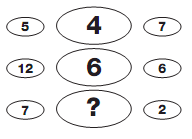
Using Euler's formula find the unknown.
| Faces | ? | 5 | 20 |
| Vertices | 6 | ? | 12 |
| Edges | 12 | 9 | ? |
Using distributivity of multiplication over addition of whole numbers, find each of the following products:
$$ 258 \times 1008 $$
Which property of addition satisfies the statement $$\dfrac{1}{5}+0=0+\dfrac{1}{5}=\dfrac{1}{5}$$.
Observe the pattern in the following and fill in the blanks:
$$9 \times 9 +7 =88 $$
$$98 \times 9+6 =888 $$
$$987 \times 9 + 5 =8888 $$
$$9876 \times 9+4 =......$$
$$98765 \times 9 + 3 =....$$
$$987654 \times 9 + 2 = ....$$
$$9876543 \times 9 +1 = ......$$
What are the whole numbers which when multiplied with itself gives the same number?
Write the first four products of two numbers with difference 4 starting from In the following order: 1, 2, 3, 4, 5, 6, .....
Identify the pattern in the products and write the next three products.
Study the following pattern:
$$ 1 = \dfrac {1 \times 2}{2}$$
$$ 1+2 = \dfrac {2 \times 3}{2}$$
$$ 1+2+3 = \dfrac {3 \times 4}{2}$$
$$ 1+2+3+4 = \dfrac {4 \times 5}{2}$$
By observing the above pattern, find
$$ 1 + 2 + 3 + 4 + 5 + 6 + 7 + 8 + 9 + 10 $$
$$ 1 = \dfrac {1 \times 2}{2}$$
$$ 1+2 = \dfrac {2 \times 3}{2}$$
$$ 1+2+3 = \dfrac {3 \times 4}{2}$$
$$ 1+2+3+4 = \dfrac {4 \times 5}{2}$$
By observing the above pattern, find
$$ 1 + 2 + 3 + 4 + 5 + 6 + 7 + 8 + 9 + 10 $$
Study the following pattern:
$$1+3 =2 \times 2$$
$$1+ 3+5 = 3 \times 3$$
$$ 1+ 3+7 = 4 \times4$$
$$1+ 3 + 5 + 7 + 9 = 5 \times 5 $$
By observing the above pattern, find
(i) $$1+ 3 + 5 + 7+ 9 +11$$
(ii) $$ 1+3+5+7+9+11+13+15 $$
(iii) $$21+ 23 + 25 + + 51$$
Determine the following sum by using suitable rearrangement:
$$2+3 +4+ 5 + 45+ 46 +47+48$$.
Observe the following pattern and extend it to three more steps:
$$6 \times 2 - 5 =7 $$
$$7 \times 3 - 12 =9 $$
$$8 \times 4 - 21 =11 $$
$$ 9 \times 5 - 32 =13 $$
$$... \times ... - ... = ...$$
$$... \times ... - ... = ...$$
$$... \times ... - ... = ...$$
Write down the smallest whole number.
Match the following:
| List I | List II | ||
| (i) | $$625 \times 436 = 625 \times 400 + 625 \times 30 + 625 \times 6$$ | (a) | Commutativity under addition |
| (ii) | $$25 \times 69 x 8= 25 \times 8 \times 69$$ | (b) | Commutativity under multiplicatio |
| (iii) | $$ 60 + 19758 + 840 = 60 + 940 + 19758$$ | (c) | Distributivity of multiplication over addition |
Write down, if possible, the largest natural number.
Write down, if possible, the largest whole number.
Write down three consecutive whole numbers just preceding $$8510001$$.
Represent the following numbers on the number line:
$$2, 0, 3, 5, 7, 11, 15$$.
Give arguments in support of the statement that there does not exist the largest natural number.
Write down the next three consecutive whole numbers starting from $$4009998$$.
Fill in the blanks to make the following a true statement:
$$53501 + (574 + 799) = 574 + (53501 + ..........)$$
Add the following numbers and check by reversing the order of the addends:
$$16509 + 114$$
Find the sum: $$(1546 + 498) + 3589$$
Also, find the sum: $$1546 + (498 + 3589).$$ Are the two sums equal? State the property satisfied.
Fill in the blanks to make the following a true statement:
$$1946 + ........... = 984 + 1946$$
Fill in the blanks to make the following a true statement:
$$864 + 2006 = 2006 + .............$$
Determine the sums given below using suitable rearrangement.
$$15409 + 278 + 691 + 422$$
Determine the sums given below using suitable rearrangement.
$$1983 + 647 + 217 + 353$$
State the property used in each of the following Statements:
$$(29 \times 36) \times 18 = 29 \times (36 \times 18)$$
Fill in the blanks to make the following a true statement:
$$68 \times 95 = 68 \times 100 - 68 \times .......$$
State the property used in each of the following Statements:
$$72 \times 98 + 72 \times 2 = 72 \times (98 + 2)$$
Determine the sums given below using suitable rearrangement.
$$3259 + 10001 + 2641 + 9999$$
State the property used in the following statement:
$$(16 \times 32)$$ is a whole number
State the property used in the following Statements:
$$19 \times 17 = 17 \times 19$$
State the property used in each of the following Statements:
$$1480 \times 1 = 1480$$
State the property used in each of the following Statements:
$$1732 \times 0 = 0$$
Find the following products, using distributive laws:
$$245 \times 1008$$
Find the following products, using distributive laws:
$$996 \times 367$$
Find the following products, using distributive laws:
$$472 \times 1097$$
Find the following products, using distributive laws:
$$947 \times 96$$
Find the value of the following using various properties:
$$647 \times 13 + 647 \times 7$$
Find the following products, using distributive laws:
$$740 \times 105$$
Find the value of the following using various properties:
$$8759 \times 94 + 8759 \times 6$$
Find the value of the following using various properties:
$$7459 \times 999 + 7459$$
Find the value of the following using various properties:
$$569 \times 17 + 569 \times 13 + 569 \times 70$$
State the property used in each of the following Statements:
$$63 \times 126 - 63 \times 26 = 63 \times (126 - 26)$$
Find the following products, using distributive laws:
$$439 \times 997$$
Find the product:
$$3709$$ $$\times 89$$
Find the following products, using distributive laws:
$$580 \times 64$$
Find the products:
$$15208$$
$$\times 542$$
Find the following products, using distributive laws:
$$3576 \times 9$$
Find the products:
$$4617$$
$$\times 234$$
Find the following products, using distributive laws:
$$2437 \times 999$$
Find the following products, using distributive laws:
$$1553 \times 198$$
Find the products:
$$458$$
$$\times 67$$
Find the following products, using distributive laws:
$$847 \times 99$$
Find the value of
$$(1573 \div 1573) - (1573 \div 1573)$$
Find the rule which gives the number of matchsticks required to make the following matchsticks patterns.
Use a variable to write the rule.
A pattern of letter $$T$$ as
How many times does the digit 3 occur at tenth's place in natural numbers from $$100$$ to $$1000$$ ?
Find the value of
$$32277 \div (648 - 39)$$
Find the value of
$$1507 - (625 \div 25)$$
In each of the following pairs, which number is to the right of the other on the number line?
$$ 3 , 5 $$
Find the rule which gives the number of matchsticks required to make the following matchsticks patterns.
Use a variable to write the rule.
A pattern of letter $$V$$ as
______ is the successor of the largest $$3$$ digit number.
If $$0$$ is subtracted from a whole number, then the result is the ____ itself.
The smallest whole number is
Whole number are closed under ______ and under ______.
Multiplication is distributive over ______ for whole numbers.
$$1001 \times 2002=1001 \times 1001 +1001 \times $$ _____
$$125+(68+17)=(125+$$_____$$)+17$$
$$786 \times 3+786 \times 7=$$ ______
How many natural numbers are there between $$102$$ and $$112$$ ? What fraction of them are prime numbers?
How many natural numbers are there between $$102 \,and \, 112$$ ? What fraction of them are prime numbers?
Work out following multiplication,
$$\dfrac { \begin{matrix} 123456789 \\ \times \ 9 \end{matrix} }{ } $$
Use the result to answer the following questions.
By what number should $$123456789 $$ be multiplied to get $$8888888808$$?
$$a(b +c) =a \times$$ __________ $$+ a \times$$ __________ .
By re-arranging the given numbers, evaluate: $$21 + 22 + 23 + 24 + 25 + 75 + 76 + 77 + 78 + 79$$
A loading tempo can carry $$482$$ boxes of biscuits weighing $$15\ kg$$ each, whereas a van can carry $$518$$ boxes each of the same weight. Find the total weight that can be carried by both the vehicles.
By re-arranging the given numbers, evaluate: $$1 + 2 + 3 + 4 + 596 + 597 + 598 + 599$$
Evaluate the following, using the distributive property.
$$(\mathbf{i})-39 \times 99$$
(ii) $$(-85) \times 43+43 \times(-15)$$
(iii) $$53 \times(-9)-(-109) \times 53$$
(iv) $$68 \times(-17)+(-68) \times 3$$
$$5 10 = .$$, which is not a
$$\Rightarrow$$ Subtraction of .. is not closed.
Which property of addition is satisfied by: $$(15 – 12) \times 18 = 15 \times 18 – 12 \times 18$$
Which property of addition is satisfied by: $$(7 + 6) \times 10 = 7 \times 10 + 6 \times 10$$
$$32 \times 15 = 32 \times 6 + 32 \times 7 + 32 \times ……….$$
$$12 * (9 6) = .. = .$$
$$12 * 9 12 * 6 = . = .$$
Is $$12 * (9 6) = 12 * 9 12 * 6= $$.
Is this type of result always true ?
Name the property used here ..
$$(16 8) * 24 = .. = .$$.
$$16 * 24 8 * 24 = .. .. = .$$.
Is $$(16 8) * 24 = 16 * 24 8*24$$ ? ..
Is the type of result always true? .
Name the property used here
$$23 \times 56 = 20 \times 56 + ………… \times 56$$
Which property of addition is satisfied by: $$8 \times (8 + 0) = 8 \times 8 + 8 \times0$$
Fill in the blank.$$229 \times ………… = 578 \times 229$$
Fill in the blank.
Fill in the blank.$$328 \times 573 = ……….. \times 328$$
Fill in the blank.
Evaluate using properties: $$924 \times 988$$.
Use distributive law to evaluate: $$385 \times 1004$$.
$$98 * 273 75 * 273 = (..)* 273 = . * 273$$
Use distributive law to evaluate: $$984 \times 102$$.
$$83 \times 54 + 83 \times 16 = 83 \times (……….) = 83 \times ………… = ……….$$
Use distributive law to evaluate: $$446 \times 10002$$.
Evaluate using properties: $$3023 \times 723$$.
Evaluate using properties: $$548 \times 98$$.
Evaluate using properties: $$679 \times 8 + 679 \times 2$$.
Evaluate using properties: $$284 \times 12 – 284 \times 2$$.
Evaluate using properties: $$55873 \times 94 + 55873 \times 6$$.
Evaluate using properties: $$8324 \times 1945 – 8324 \times 945$$.
Identify the property in the following statements.
8 X (6+5)= (8X6) + (8 X5)
Evaluate using properties: $$3333 \times 987 + 13 \times 3333$$.
Fill in the blank.$$(437 + 3) * (400 – 3) = 397 * ……….$$
$$66 + 44 + 22 = 11 * (..) = 11 * .$$
Evaluate using properties: $$7984 \times 15 – 7984 \times 5$$.
Define a new addition e on (be set of all natural numbers by $$ m ^{\ast} n = m^{2} + n^{2} $$
(i) Is N closed under e ?
(ii) Is $$^{\ast} $$ commutative on N ?
(iii) Is $$^{\ast} $$ associative on N ?
(iv) Is there an identity element in N with respect $$ ^{\ast} $$ ?
Evaluate: $$9999 \times 8$$.
Show that: Division of whole numbers is not closed. Give two suitable examples.
Name the property indicated in the following:
$$\frac { 8 }{ 17 } +\frac { -8 }{ 17 } =0$$
Name the property indicated in the following:
$$\frac { 8 }{ 9 } \times 1=\frac { 8 }{ 9 } $$
Check the commutative property of multiplication for the following pairs
$$\frac { -7 }{ 13 } ,\frac { 25 }{ 27 } $$
Check the commutative property of addition for the following pairs.
$$\frac { -7 }{ 9 } ,\frac { -18 }{ 19 } $$
In the set of all rational numbers, give 2 examples each illustrating the following properties.
i. Associative
ii. Commutativity
iii. Distributivity of multiplication over addition.
Simplify the following using distributive property
$$\frac { 5 }{ 12 } \times\left( \frac { 25 }{ 9 } +\frac { 32 }{ 5 } \right) $$
Check the commutative property of addition for the following pairs.
$$\frac { -8 }{ 13 } ,\frac { 23 }{ 27 } $$
Simplify the following using distributive property
1) $$\frac { 2 }{ 5 } \times\left( \frac { 1 }{ 9 } +\frac { 2 }{ 5 } \right) $$
Check the commutative property of multiplication for the following pairs
$$\frac { 22 }{ 45 } ,\frac { 3 }{ 4 } $$
Check the commutative property of multiplication for the following pairs
$$\frac { -8 }{ 9 } ,\frac { -17 }{ 19 } $$
$$\left( \frac { 51 }{ 2 } +\frac { 7 }{ 6 } \right) \div \frac { 3 }{ 5 } $$
(3) $$\frac { 8 }{ 9 } \times\left( \frac { 11 }{ 2 } +\frac { 2 }{ 9 } \right) $$
(ii) $$\left( \frac { 22 }{ 7 } +\frac { 36 }{ 5 } \right) X\frac { 6 }{ 7 }$$
Prove that the fraction $$\displaystyle \frac{m(n+1)+1}{m(n+1)-n}$$ is irreducible for every positive integers $$m$$ and $$n$$.
Prove that any integer $$a \ge 7$$ is the sum of two relatively prime integers. (We say two integers $$m$$ and $$n$$ are relatively prime if their HCF (i.e., GCD) is $$1$$)
Simplify the following using the rules for identities :
(i) $$28\times 32$$
(ii) $$102\times 98$$
Is $$(8\div2)\div 4 = 8 \div(2\div 4)?$$ is there any associative property for division?Check.
What is the least number of square(s) which must be shaded to make the given figure symmetric along the dotted line?
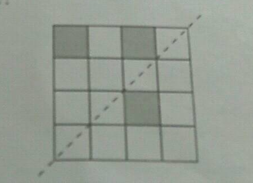
Sakharam was playing the field from 3 in the morning At 12:30 in the after he not stopped and started for home. He reached home at 9:How long was he playing the field? How long did it take him to reach home from the field .
Add together $$5, 15$$ and $$25$$ and divide the sum by $$9$$.
The number of ways in which the number $$10800$$ can be resolved as a product of two factors.
Class 6 Maths Extra Questions
- Algebra Extra Questions
- Basic Geometrical Ideas Extra Questions
- Data Handling Extra Questions
- Decimals Extra Questions
- Fractions Extra Questions
- Integers Extra Questions
- Knowing Our Numbers Extra Questions
- Mensuration Extra Questions
- Playing With Numbers Extra Questions
- Practical Geometry Extra Questions
- Ratio And Proportion Extra Questions
- Symmetry Extra Questions
- Understanding Elementary Shapes Extra Questions
- Whole Numbers Extra Questions
